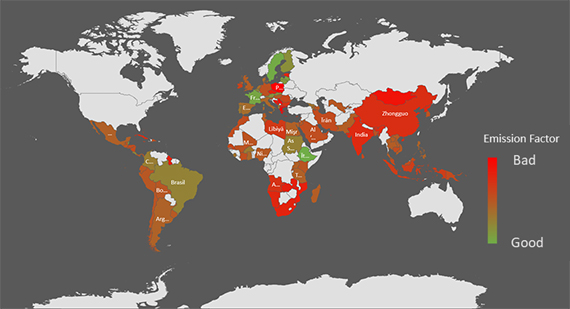What are RECs & other Energy Attribute Certificates (EACs)?
Energy Attribute Certificates are contractual instruments with information about electricity consumption: eg. Guarantees of Origin (EU), Renewable Energy Certificates (USA).
All the people, activities, resources, and information that contribute to the transformation of raw materials into finished goods and services are considered part of the supply chain. In gray power markets fossil fuel power plants are used. Many energy buyers are using standard electricity contracts, but now need to lower their emissions. Power Purchase Agreements, along other contracts, can help an energy buyer to fulfill their sustainability strategy.
OVERVIEW


„gray“ power markets are characterized by utilities running fossil fuel power plants. High electricity prices in “gray” power markets due to high levelized costs of electricity and additional costs for purchasing Emission Allowance Certificates (EAC).
Energy buyers face two major problems in consuming “gray” electricity:
The supply chain is everything which contributes to the transformation of raw materials into finished goods and services. It consists of multiple production steps. This can be manufacturing from natural resources, transferring and storing commodities, and delivering finished goods to customers.
Sustainability matters for an increasing number of companies and public institutions. However, the vast majority is still using standard electricity contracts. The standard scenario consists of a short-term Power Purchase Agreement (PPA) with a 1-3 years tenor, closed between energy buyers and a municipal utility.

The graph above shows the interaction of related parties under those standard utility PPAs. Read more about merchant PPAs or corporate PPAs on our specific blog articles.
The physically delivered electricity under those PPAs is a mixture of electricity generated from various technologies like fossil fuels, nuclear, and renewables. It is impossible to separate renewable electricity from other energies in the mid- and downstream market. This can be done by bundling different technologies in one portfolio of electricity generation at the upstream market.
The resulting electricity is finally distributed to the buyers who are unable to assign the MWh consumed to a particular power plant. In addition, the electricity price for a gray product might be higher than a 100% green product. Eg. The net cost for generating electricity, excluding grid fees and levies, is lowest for renewable energy plants. Levies are also known as Levelized Cost of Energy or LCOEs.
In sum, the current European power markets remain on a high level for corporate clients as shown in the graph.

The graph shows the high average electricity price for corporates and also the high heterogeneity of these prices across countries. Sweden is one of the cheapest electricity markets with 67 EUR/MWh as of 2018 for corporate with medium electricity consumption. In contrast, Germany is more than twice as expensive with 148 EUR/MWh for the same year.
Utilities which are generating their electricity from fossil fuels need to buy Emission Allowance Certificates (EACs) in order to operate fossil fuel power plants. An emission certificate allows for emitting a certain amount of Greenhouse Gases and are traded on secondary markets.

In order to support the international competitiveness of European companies, energy intensive companies get state aid on their invoiced electricity costs. The state aid is leading to lower electricity prices invoiced to electricity intensive sectors.
This is one major factor why prices in “gray” electric power markets not only differ across countries but also across industry sectors. The graph shows the discrepancy between medium and larger corporate electricity consumers.

Scope 1 emissions are ghg emissions caused directly by their own business activities. For example, carbon dioxide is blown through the factory’s chimney because of manufacturing activities.
In the electricity sector, this is caused by utilities running fossil fuel power plants. Utilities must participate in markets for carbon emission allowances. These have to be purchased for allowing the utility to issue a certain amount of carbon dioxide. Scope 1 emissions in the electricity generating sector normally result in higher electricity prices invoiced to energy buyers.
Scope 2 emissions are indirect emissions caused by the consumption of purchased electricity. Assuming a gray electricity market, the energy buyer increases the Scope 2 emissions by increasing its consumption of purchased electricity. This happens since the utility, which produces and delivers the electricity, has to increase its electricity output provided by fossil fuel plants.
The energy buyer can reduce these emissions by procuring green energy through standardized green products like e.g. Corporate Power Purchase Agreements (PPA or CPPA).
Finally, a Scope 3 emission covers the greenhouse gas issuance caused by stakeholders within an energy buyer’s value chain. That means emissions can occur in the upstream as well as at the downstream part of the value chain.
In addition to this, Scope 3 emissions can also be caused by a corporate or public institution itself by e.g. business travels via airplanes.

This map shows the greenhouse gas emissions (GHG) in selected grids. The majority of the emissions occur in emerging markets or developing countries. The Greenhouse Gas Protocol counts three types of emissions. These affect the global carbon footprint of a corporate or a public institution: Scope 1 2 and 3 emissions.
To summarize, corporates and public end-consumers are mainly facing two major issues in the current “gray” electric power markets:
Depending on the amount of their electricity consumption, commercial energy buyers like corporates or public institutions pay high electricity prices. Especially if they do not fall under the described state which is the case for most of the companies.
Energy buyers do not have the opportunity to directly influence their climate strategy and are, therefore, still contributing to Greenhouse Gas Emissions. Consequently, they are limited in achieving their climate targets and the sustainability strategy in terms of their electricity consumption.